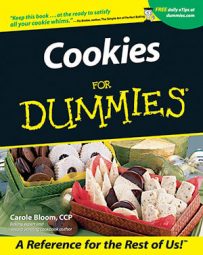In regular cooking, you can get away with adding a pinch of this and some of that. But in cookie baking, it's important to pay attention to the quantities of ingredients that each recipe calls for. If you add extra amounts or not enough of an ingredient, you're not going to end up with what you expect. Most likely, you'll have a failure on your hands. Who needs that? Dry and liquid ingredients are measured with different types of measuring cups because of their particular characteristics. By following correct measuring techniques for each type of ingredient, you'll guarantee success for each cookie recipe you tackle.
Sift the flour if the recipe calls for it. When flour is sifted, air is added to it, lightening it, getting rid of any lumps, and increasing the volume. Some recipes call for flour to be measured first and then sifted. This is different from sifting the flour before it's measured. The order of these steps makes a difference in the final amount of flour and in the finished cookies. Each recipe is written in a particular way because that's how it works. The best policy is to follow the recipes step by step, and you're sure to come out with great cookies every time!
Checking and double-checking is a good idea when measuring ingredients.
Measuring dry ingredients
There are two main methods of measuring dry ingredients:
- The scoop-and-sweep method involves scooping the measuring cup into the ingredient and then sweeping off the excess at the top with a long, flat implement, such as a spatula or a knife. This method is quick, easy, and accurate.
- Use the scoop-and-sweep method to get an accurate measure with measuring spoons. Many boxes of baking soda, cans of baking powder, and some spice containers have a straight side so that you can level off the spoon as you draw the ingredient from the container.
- Lightly spoon the ingredient into the cup and then sweep off the excess at the top with a long, flat implement, such as a spatula or knife. This method aerates the ingredients. It works well but takes more time than the scoop-and-sweep method.
Brown sugar traps a lot of air between its crystals, so pack it down in the cup to get an accurate measurement. The same method is used for measuring shortening. For ingredients such as coconut or chopped nuts, spoon them into the cup and press down lightly.
Sweep off the excess ingredient over the container holding it, not over the mixing bowl, or you'll have more of the ingredient than you need in your recipe.
Measuring liquid ingredients
When measuring liquid ingredients, use a liquid measuring cup. Pour the ingredients carefully into the cup until it reaches the desired amount. For accuracy, place the measuring cup on a flat surface and read the measurement at eye. Reading the liquid level from above looks different than at eye level. Too much liquid will throw off the recipe. If you have more of the specific liquid than the recipe calls for, pour it out by using the liquid measuring cup's pour spout.
Measurement equivalents
Knowing the equivalents of various measurements is helpful in case you have to adjust a recipe. Table 1 shows equivalents for commonly used measurements.
Table 1: Common Measurement Equivalents
Dry ingredients |
3 teaspoons = 1 tablespoon |
2 tablespoons = 1/8 cup |
4 tablespoons = 1/4 cup |
5 tablespoons plus 1 teaspoon = 1/3 cup |
8 tablespoons = 1/2 cup |
12 tablespoons = 3/4 cup |
16 tablespoons = 1 cup |
Liquid ingredients |
1 pint = 2 cups |
1 quart = 4 cups |
Weights |
1/2 pound = 8 ounces |
1 pound = 16 ounces |
Sifting
Sifting is a straightforward activity. If the flour is to be measured and then sifted, simply measure the amount of flour called for in the recipe into dry measuring cups. If other dry ingredients (such as baking powder or spices) are to be sifted with the flour, measure those and add them to the sifter. Then work the contents through the mesh screen of the sifter onto the wax paper.
On the other hand, if the flour is to be sifted and then measured, sift it and then carefully spoon it into a dry measuring cup. When the quantity you need is correctly measured, return any excess flour to its canister or other receptacle. If other dry ingredients are to be sifted with the flour, measure them and resift the flour with them.
If you don't have a sifter, you can use a fine mesh strainer instead.

